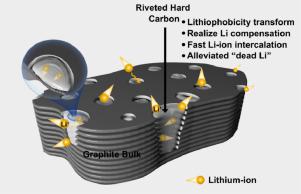Energy Storage Materials ( IF 18.9 ) Pub Date : 2022-06-01 , DOI: 10.1016/j.ensm.2022.05.056 Peng Du , Xinming Fan , Bao Zhang , Liang Cao , Jiancan Ren , Xing Ou , Xueyi Guo , Qi Liu

|
The extensive use of electric vehicles has raised the requirement of fast-charging for lithium-ion batteries. However, conventional graphite anode suffers from lithium dendrites and unacceptable capacity fade during fast charging. The limited ion channels and lithiophobic nature hinder the application of graphite in fast charging. Besides, the formation and accumulation of “dead lithium” accelerate the capacity decay during long-term cycling at high current density. Here, lithiophilic hard carbon-riveted graphite (HCRG) anode is delicately designed and fabricated to overcome the influence of “dead lithium” and meet the requirement of fast charging. The riveted heterostructure plays a crucial role in the lithiophobic-to-lithiophilic transition of graphite surface and the lithiophilic surface of HCRG can attract more Li-ions and facilitate re-intercalation of Li-ions into graphite bulk in relaxation time at low potential rather than plating on the surface, which effectively decreases the polarization and increases the proportion of reversible lithium at high current density. As a result, it exhibits excellent rate performance with 98.2% capacity retention when rate increasesing from 1 C to 15 C and fast-charging performance with 90.1% energy retention after 4000 cycles at an ultrahigh rate of 10 C in LiFePO4/HCRG full-cell. This strategy of constructing riveted heterostructure efficiently boosts the lithium intercalation reaction. It achieves fast-charging performance, highlighting the comprehensive understanding of interfacial kinetics and structure optimization for other fast-charging anodes.
中文翻译:

石墨向超快充电和长循环锂离子电池的疏锂到亲锂转变
电动汽车的广泛使用对锂离子电池的快速充电提出了更高的要求。然而,传统的石墨负极在快速充电过程中会出现锂枝晶和不可接受的容量衰减。有限的离子通道和疏锂性质阻碍了石墨在快速充电中的应用。此外,“死锂”的形成和积累加速了在高电流密度下长期循环过程中的容量衰减。在这里,亲锂硬碳铆接石墨(HCRG)负极经过精心设计和制造,以克服“死锂”的影响,满足快速充电的要求。铆接异质结构在石墨表面的疏锂-亲锂转变中起着至关重要的作用,HCRG的亲锂表面可以吸引更多的锂离子并促进锂离子在弛豫时间内在低电位下重新嵌入石墨块体中,而不是表面镀层,有效降低极化,增加高电流密度下可逆锂的比例。结果,它表现出优异的倍率性能,当倍率从 1 C 增加到 15 C 时,容量保持率达到 98.2%,在 LiFePO 中以 10 C 的超高倍率循环 4000 次后,具有 90.1% 的能量保持率的快速充电性能。在高电流密度下有效地降低了极化并增加了可逆锂的比例。结果,它表现出优异的倍率性能,当倍率从 1 C 增加到 15 C 时,容量保持率达到 98.2%,在 LiFePO 中以 10 C 的超高倍率循环 4000 次后,具有 90.1% 的能量保持率的快速充电性能。在高电流密度下有效地降低了极化并增加了可逆锂的比例。结果,它表现出优异的倍率性能,当倍率从 1 C 增加到 15 C 时,容量保持率达到 98.2%,在 LiFePO 中以 10 C 的超高倍率循环 4000 次后,具有 90.1% 的能量保持率的快速充电性能。4 /HCRG 全电池。这种构建铆接异质结构的策略有效地促进了锂嵌入反应。它实现了快速充电性能,突出了对其他快速充电负极的界面动力学和结构优化的全面理解。










































 京公网安备 11010802027423号
京公网安备 11010802027423号